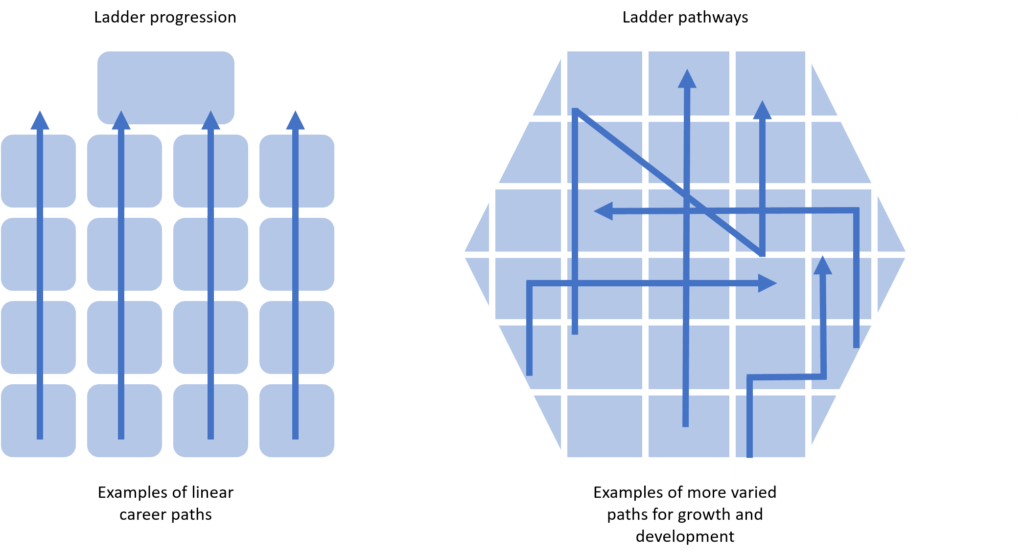Recently, Mentorloop’s Guy Lambert had the pleasure of sitting down with Steph Bright of Capita Learning for an in-depth discussion around the immediate need to innovate and how to build a strong culture of innovation.
Steph and Guy re-discover the importance that boredom plays in innovation and how to support our people to learn and collaborate in such a complex and taxing time.
Listen to the rest of the chat above, or read the transcript below:
Guy: So Steph, thanks for joining me maybe before we launch into the conversation tell me a little bit about the work you do with Capita Learning.
Steph: Sure, so I’ve been in my current role at Capita Learning for about two years now in the service design team, and so I work on mostly managed service solutions. So where large companies outsource a lot of their learning and development function, we run administration consultancy, supply management and then we also work on smaller, niche programs of learning and consultancy that we can deliver to our clients. I’ve also previously worked at Brightwave which is also part of the Capita Learning group, so a lot of experience with products in the digital learning space.
Guy: Obviously where we’re all about the digital learning space at the moment, still stuck at home. One thing I’d love to chat through, is the need to kind of continue to innovate and I think you know it is an important thing to be able to do probably more so than ever at the moment, but let’s just kick off with:
Why is innovation so important generally speaking but more so now, in the ‘new normal’?
Steph: A big, big and good question! Innovation is a word that frustrates me quite often actually because I think people think of it as a big solution to something that’s really ‘out there’, comes with bells and whistles, is high-tech and whizzy, whereas really it’s about doing something better more efficiently.
I think at the moment given the situation we’re in, in the current crisis, lots of organisations obviously realise that they need to change the way that they do things and that might not necessarily be on a massive scale, it might just be tweaking small things like parts of their process. I think in order to keep commercially attractive, remain profitable in this kind of time and keep your workforce engaged and happy (which is obviously quite a challenge at the moment), innovation is really really important and it’s been important for a while now.
Lots of clients we work with at Capita, for example in financial services, are tech disruptors now and they’re coming into the market with new products and services all the time. Keeping ahead of that trend and competing with them when they function in a more agile and nimble way is quite difficult. I believe that will only continue as we go through this process as well.
When you work with some of your clients, do you find there’s a capability gap that needs to be filled in some way?
Steph: They definitely have the capability, but I think there are a few aspects to it I guess. There’s the skills inability in terms of skills and people, and capability in terms of business structure and how you can adapt your services and how easily you can do that depending on your size. We tend to work with quite big clients, so I think that’s where there might be more of a challenge.
A startup that has maybe 10 people, can try, test, pilot and prototype and it doesn’t have as much of an impact, whereas I think it can be a bit more tricky and to get those things across the line when you’re in a large organisation that’s always done things in a certain way or may, be highly regulated as well.
Guy: So it’s sort of that old analogy of turning a bigger ship I guess, is what I’m hearing. That is, it’s going to take longer and require more resources than if you were in a little nimble, yacht where you can pivot relatively quickly.
Steph: You still obviously need those skills and that’s what a lot of our clients are talking to us about. They come to us to learn how to develop these sorts of critical capabilities that would support innovation and allow them to be more agile and allow them to develop new products and services that are really customer-centric and I guess more in line with what the disruptor type brands are doing. We talk a lot about those kinds of skills and capabilities; problem-solving, critical thinking, creativity and communication. They’re at top of the agenda at the moment.
What are some of the interventions you’ve seen work or have been working through?
Guy: How do you move the needle on some of those things? I’m hearing problem-solving and creativity, but arguably, creativity is something that’s hard to learn. It could probably be unlocked or encouraged, but how do you move the needle on something like that in say a three month period?
Steph: I think they’re really tricky, and they’re tricky to think about. In terms of our education system, those things aren’t necessarily taught. So, when we get to a stage of workplace learning interventions, it’s odd to think about how much of a challenge that is because we really should have developed them already. Throughout our education we tend to have information given, we digest it and we have to feed it back and so you don’t develop those problem-solving skills as early on as we could. In turn, it’s a lot harder later on.
Where I’ve seen when things like that work well, at Google for example which we were looking at recently, they run a series of designs sprints where they take a problem and create a team around it to try and understand the problem. They then develop potential prototype solutions to it and test them. It’s a very kind of agile way of developing a new solution.
That approach works really well, but what they require is obviously time to do them, to allow people to take five days, or however long, to solve a specific problem. The solutions that work well are practical, where you see people who want to be a problem solver getting to actually go through the process of solving a problem, as opposed to finding an e-learning course on how to problem solve – which isn’t really an effective intervention.
You really have to really get in and do it and that’s where it sometimes poses a challenge – having the space and the environment to be able to develop those skills, as well as the time. Obviously people are under pressure a great deal at the moment, to maintain continuity of core products and services, let alone thinking about new ones, so it could be quite a challenge in this current situation. How much is a company is willing to invest in innovation and the future now when they’re probably a bit restricted in terms of their workforce numbers? Especially when they’re just trying to keep the core business afloat.
Guy: That reminded me of a perk that Google quite famously has where, I think, ten or twenty per cent of an employee’s time is actually given to research and development – a day, a week or similar, to work on a project of your own which I think typically falls into, like you said, being able to step back and problem solve.
Steph: Exactly. There’s ta really good TED talk about where good ideas come from – for example, in the shower or when you’re just sitting in the park because your brain really has to be switched off. Instead, while you’re looking at your emails or participating in everything else, it’s very unlikely that you’ll have that light bulb moment of, “Hey, we could this.”
Guy: It’s about leaning into boredom or something like that, isn’t it? Where you sort of just have to let your mind wander a little bit.
Steph: The other thing I think is really interesting is, allowing people to explore other topics that don’t necessarily relate to what they might do in their day job but could be relevant. To give you an example, I read a really good book called Invisible Women, where a female physicist who had learned to crochet when she was younger, was now trying to create a 3D mathematical model. She connected those two things immediately and thought of a way to use crochet to articulate and create a 3D form of a mathematical model. I think that’s really interesting because a lot of the great ideas you’ve probably had, come from something completely unrelated to that idea – it’s often just something you’ve picked up elsewhere down the line and made a connection.
Guy: In some ways, that speaks to the needs of an organisation – to create teams that are not in silos. For example, if an organisation is “looking to innovate”, they could get a working group together that’s made up of ten people from ten completely different areas of the business and give them the time and space to look at data, lean into being bored potentially, or at least think about the problem they’re going to be solving.
Steph: Yeah exactly. I really like the idea of a company taking a business problem that they’ve got, creating a ‘swap team’ around that problem from different disciplines or different areas of the business and giving them time to actually work on it. I think that would be a really effective way of not only trying to come up with a solution to a problem but allowing those people to work together, to learn about other parts of the business and learn about design – service design and product design – and what actually goes into all the products that you build to serve a client. That process of allowing people to collaborate in that way could be a really good solution.
Guy: My mind is going further down the track to thinking about how you incentivise that as well. If you’re an executive and/or an organisation, if you’re setting goals that are maybe “too easy” it doesn’t really encourage any innovation. You need to be setting stretch goals and creating a culture that requires some creativity to reach them.
Steph: Lots of organisations that we speak to want to be able to give employees the opportunity to understand how they might articulate three pillars of learning:
- I know what to do in my job now,
- I know where I can develop and progress in that role – but also –
- I understand and know where I might go in the future.
For example, how do you support an employee from being a call centre agent to a data scientist? How how do you help them see that leap?
Collaborative problem-solving focus sessions are a really strong way of allowing people to see what other roles are like, can spark interest, and allow them to potentially move across the organisation into different areas of the business – rather than moving along a typical upwards trajectory, and instead in a lattice effect:

How do you continue to innovate while we’re all working from home? Is it as simple as getting a diverse group of people together on a video call or is there a better way?
Steph: I don’t necessarily think I’ve nailed it, but I’ve definitely found things that we’ve done as a team that has helped. As you can see, I’m a brown paper and post-it note lover. For me, having something that I can scribble on every now and then and get my thoughts down on paper rather than a screen is important. I definitely think there’s a difference between writing something down and typing it, in terms of how much it sticks.
As a team, we’ve been trying ‘silent teams sessions’ – where for two hours in one afternoon we all work on the same project with everyone on the same call to bounce ideas off, if and when we need to. It recreates that feeling of you being in the same room, but you don’t need to talk to each other if you don’t need to. It creates less of a barrier for people to collaborate and seek feedback.
I’ve also found that meetings are tricky in this environment because it’s harder to get to output or resolution. I think because everyone’s so used to being in meetings or on calls talking, it can sometimes end up with too much talking.
You may have an output that you need to get to, but it’s hard to create the right framework to get there when you’re not in a room together or when someone might want to collaborate on a whiteboard for example. I think if you can go into a meeting with an agenda, shared document or template, or anything that assists you in channelling the energy towards a focal point – that is useful.
Mentorloop would like to thank Steph Bright for her valuable time and you can reach her via her social channels on Linkedin and Twitter.




